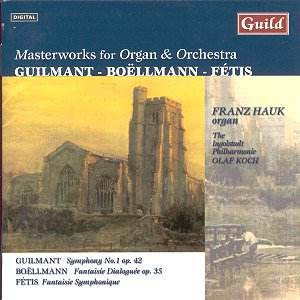Alexandre GUILMANT (1837 - 1911)
Allegro Op.81 (1894)
Marche Fantaisie Op.44 (1875)
Meditation sur le Stabat Mater Op.63 (1884)
Final alla Schumann Op.83 (1895)
Symphony No.l in D minor Op.42 (1874, rev. 1877)
Leon BOËLLMANN (1862 - 1897)
Fantaisie Dialoguee Op.63 (1896)
François-Joseph FÉTIS (1784
- 1871)
Fantasie Symphonique (1866)
 Franz Hauk (organ)
Franz Hauk (organ)
The Ingolstadt Philharmonic/Olaf Koch
Recorded Ingolstadt August 1995
 GUILD MUSIC GMCD 7215
[73:44]
GUILD MUSIC GMCD 7215
[73:44]
AmazonUK
AmazonUS
Amazon
recommendations

Alexandre Guilmant, who, with Vincent d'Indy, was one of the founders
of the Schola Cantorum, was also a major exponent of the French organ revival
in the mid-19th Century. As the works recorded in this intelligently planned
programme show, he was also a very distinguished composer.
The Allegro Op. 81 is a brilliant Toccata for organ and orchestra whereas
the Marche Fantaisie sur deux Chants d'Eglise Op. 44 is somewhat lighter
in mood. The expressive mood is rather restrained for the first third of
the piece. Then, a mighty crescendo leads to a powerful peroration when both
themes combine to great effect. By contrast, the beautiful Meditation sur
le "Stabat Mater" Op. 63 unfolds peacefully throughout. This is a little
gem. Final alla Schumann sur un Noel languedocien is either a light-hearted
homage to the German composer or an affectionate pastiche. In any case it
is a delightful short work with a good deal of humour, something you would
not readily associate with music for organ and orchestra. The Symphony No.
1 in D minor Op. 42 is undoubtedly a major work. This, a reworking of Guilmant's
Organ Sonata Op.42, was first performed in 1878. The First Symphony is in
three movements: the Introduction et Allegro opens with a vigorous, declamatory
passage leading into the Allegro section based on two main subjects that
make for much of the symphonic argument. (The second subject is redolent
of Franck.) The beautiful Pastorale is quite simply one of Guilmant's most
ravishing inventions. No wonder that this exquisite movement was encored
at the first performance. The conclusion is another brilliant, lively Toccata.
For anecdote's sake, it may seem curious that Guilmant dedicated his First
Symphony to Leopold II, king of Belgium, whose rather unenthusiastic attitude
to music ("expensive noise") is well-known. However Guilmant's First Symphony
unquestionably ranks with the finest works ever written for organ and orchestra.
A real masterpiece.
Leon Boëllmann is generally best-known for his Suite Gothique
for organ and may also be remembered for his beautiful Variations Symphoniques
for cello and orchestra which Paul Tortelier recorded years ago. His lovingly
crafted Fantaisie Dialoguée Op.63 of 1896 is a quite likeable piece
- well worth hearing. It opens with a powerful introduction leading into
a more flowing theme. The music then develops into a playful Scherzo. A
restatement of the main theme leads to a rousing apotheosis - quite impressive
in its short length.
Though he played a considerable role in the then young Belgian musical life
(he became the first head of the Brussels Conservatoire), Fétis
may not have been a great composer, though a quite competent one. His
Fantaisie Symphonique of 1866 was written to celebrate the 50th anniversary
of the Royal Academy of Science in Brussels and its first performance also
coincided with the inauguration of the new organ of the concert hall of the
Brussels Conservatoire. Fétis was never one to shy from writing the
big celebratory piece and the orchestra at the time of the first performance
of the Fantaisie Symphonique included 90 strings! Fétis's music has
been much influenced by German composers, including Beethoven and Mendelssohn,
and this particular piece is a good example of his well-crafted, though at
times eclectic music: the first movement, adhering roughly to the symphonic
allegro pattern, is followed by a song-like Andante con Variazioni. The last
movement is a grand finale with sonorous hunting horns and thunderous organ
chords.
The present release is most welcome. All this music is rarely heard, if at
all, in concerts. The Guilmant works and the piece by Boëllmann are
very fine and deserve to be better known, while Fétis's work may be
more of historical than musical interest but nevertheless well worth the
occasional hearing. All of the performances are strong: Franz Hauk is superbly
supported by the Ingolstadt Philharmonic conducted by Olaf Koch. Recording
works for organ and orchestra may often be rather tricky. However the recording
team here worked wonders in coping with the reverberant nave of Ingolstadt
Munster.
Full marks to all concerned. Really well worth investigating.
Hubert Culot
See also review by Raymond Walker

